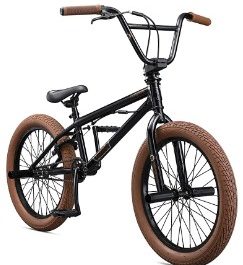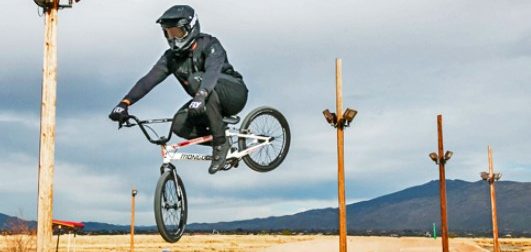Ever since Bob Haro popularized BMX bike tricks in the early 70s, the sport has grown in great leaps and bounds. A visit to a BMX contest, and you’ll be gasping every now and then from the daredevil stunts at display. So, can BMX bikes pedal backwards, or it’s a reserve for the BMX greats?
Yes, it is possible to pedal backward on a BMX. However, since BMX bikes have no reverse gear, you’ll not move in a backward direction. You only pedal backwards without moving in the same direction.
A move back by BMX bikes is called a roll and is what riders start with to perform certain tricks such as “fakie.”Generally, a roll starts from a slanted position such as a ramp, a small gradual hill, or a driveway.
Now, let’s get into the technicalities of how that happens, shall we?
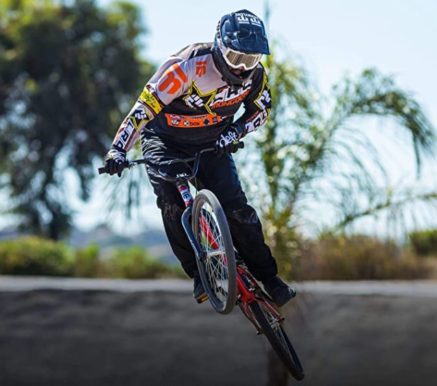
Why Can BMX Bikes Pedal Backwards
Usually, the cranks rotate and engage the sprocket when a rider pedals, driving the chain forward. This forward movement of the chain moves the rear hub.
The rear hub, located at the rear axles of the bike, connects the wheel to the frame by spokes. It holds an axle and has bearings so the wheels can spin freely.
Essentially, the rear hub is responsible for delivering power from the pedals to rotate the wheel. When you pedal forward, components in the hub attach to the teeth on the hub surface, allowing forward movement.
When you pedal backward, however, the elements in the hub disengage. So, while you can pedal backward, you cannot achieve backward movement.
Types of BMX Hubs
BMX bikes come in three main types of hubs:
1. BMX Cassette Hubs
Cassette hubs contain internal clutching mechanisms to enable movement when the rider steps on the pedals. Certain brands, such as the Profile Elite Hub (Check on Amazon), have 204 engagement points to create instant pedal engagement.
You will know you have a cassette hub by the distinct click when you backpedal or coast. Also, when you move your bike backward, you will notice the pedal moving backward.
Therefore, if you ride backward with a cassette hub, you also have to pedal back. Cassette hubs are generally more robust – a perfect fit for the extreme sport that is BMXing.
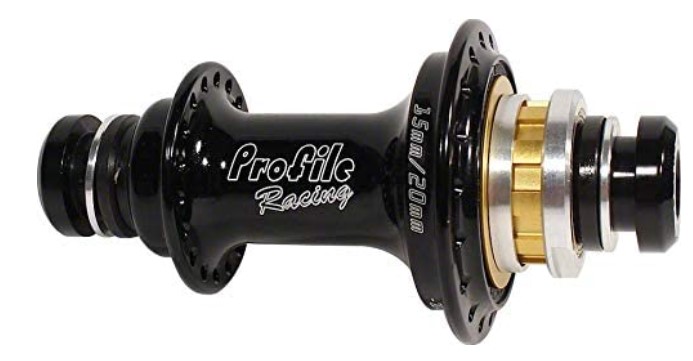
2. BMX Free Coaster Hubs
Free coaster hubs differ from cassette hubs in three ways. First, you do not have to pedal backward when riding back on a free coaster hub. Secondly, unlike the cassette hub, the free coaster is silent since it does not have pawls.
And finally, free coaster hubs do not engage immediately because of “slack”, – which is how much you pedal forward before the hub engages. However, a rider can adjust the slack to their liking.
If you’re a free coaster fan, check out the KHE Greyhound Free Coaster, which allows you to adjust the free coaster gap without removing the shell.
Imagine that! Just an Allen wrench and you’re okay. However, it’s worth mentioning that free coaster hubs are a bit pricey.
3. BMX Coaster Hubs
The distinct feature of the coaster hub is that backpedaling engages the brakes. You will know you have a coaster hub if you see an arm attached to the chainstay from the rear axle.
A coaster hub has a clutching and drive system within it that does the following: moves the bike forward when you pedal along, coasts when you stop pedaling and engages the brakes when you backpedal.
Coaster hubs are usually present in kids’ bikes and entry-level BMXs.
Now that you know the different types of hubs available, what maintenance routine should you undertake?
BMX Bike Hub Maintenance – The To-Do List
The hub system will gunk up due to general use. The result of such build-up of gunk is that the system will slow down and sometimes even slip out.
Here are a few steps for quick hub maintenance before heading for a full hub service:
- Remove the rear wheel from the bike, followed by the cassette.
- Next up is the end cap. After which, you can pull out the axle with the freehub body on it.
- Take care as the pawl system have components that can easily get lost. Ensure that you have a piece of cloth for placing the parts you’re removing.
- Place everything in the same order that you remove them. It will help a great deal when you’re replacing the components.
- To wipe the hub’s internal parts, apply some degreaser, such as this Park Tool CG-2.4 cleaning kit with a chain scrubber and gear brush.
- Do not spray the degreaser directly. Spray onto a clean cloth and wipe.
- Use a screwdriver with a cloth covering its tip to remove the stubborn gunk stuck on the drivetrain.
- Check whether the pawls are nice and clean. If not, carefully remove each pawl and its spring, taking care not to fire up the springs.
- Apply a degreaser using a cloth. Again, do not spray the degreaser directly as this will damage the internal bearings and make them wear out faster.
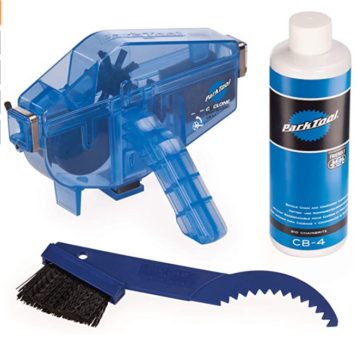
And More
- Remember to clean the pawls and springs as well. Your freehub body should look new.
- Reinstall the springs and pawls in the freehub body, taking care not to lose any components. Actuate the individual pawls and springs to ensure that they work correctly.
- Apply a high viscosity PTFE lube such as this Super Lube 51004 (Check on Amazon) to the pawls and actuator springs. Remember to lube the ratchet ring in the hub while at it.
- Reinstall the axle and use a little more lube before entirely fitting the pawls.
- Push the axle into place once you have applied lube.
- Fit the wheel back, turn it and listen to the sweet sound of the pawls engaging the drive train – a testament that the springs are working correctly.
Now that you know it’s possible to pedal backward, which types of hubs you can run and how to maintain them, let us talk about why BMX riders backpedal.
Why Do BMX Riders Backpedal
Backpedaling helps a rider transition from one trick or stunt to another. It is also a critical skill to learn to help you jump over obstacles such as curbs and use half pipes and walls.
There are also health benefits that come with backpedaling.
According to one study, the quadriceps, which are the front upper leg muscles, are engaged more when backpedaling – by up to 17.5%. Their strength is thus improved.
Backpedaling also increases the heart rate by an estimated eight beats per minute. And the sweetest news to the ears is that riders that pedaled backward improved their expenditure of calories.
You will reap these fantastic benefits and more with increased hours riding your BMX.
And finally, how about a few tips to help you master backpedaling?
BMX Bikes Backwards Pedaling Tips – Even for those over 40 years!
To master backpedaling, new riders should look for a slight inclination on a driveway if they do not have a ramp. More experienced riders can use straight walls or transition from other tricks into a “fakie.”
We’ve got you covered for those who know how to fakie at slow speed but get stuck soon after. Read on to find tips to help you master speedy fakies.
- With your bike in reverse, start with one foot on the pedal and slightly push yourself back to get a reverse momentum. Some riders prefer starting seated on a bike with a longer seat post as it is much easier to roll backward.
- If your bike has a cassette hub and you’ve started rolling backward, the pedals will begin moving back as well.
- Remember not to go wild with your pedaling or apply pedal pressure. Doing this will mess with your balance.
- Maintain your center of gravity by bringing the bike underneath you without leaning too much on either side. And if you feel like you’re falling, gently shift your weight over the rear wheel. Then steer into the direction you’re falling.
True, understanding the physics involved in executing a “fakie” – or bike riding in general – is more complicated than doing it. However, you’re better prepared once you’ve read and understood the basics.
So, get out there, hop onto your bike, and start. Oh, and don’t forget to look at the stem. It will help with your balance as you “fakie.”
FAQs (About BMX Bikes Pedal Backwards)
Is Pedaling Backwards Bad for Your Bike?
For bikes with single-speed gears like BMXs, pedaling backward causes no harm. The BMX bike’s hub is built for backpedaling and coasting. Backpedaling can damage the derailleur between gear shifts for cycles with multiple speed gears, such as mountain bikes.
Are BMX Pedals Reverse Threaded?
Reverse threads are present on the left-side pedals on BMX bikes. Reverse threading ensures that the pedal does not come loose when pedaling. The reason for this is explained by an engineering concept called mechanical precession.
In this process, a round object rolling in a circular ring in one direction will itself turn in the opposite direction.
In Conclusion – Can BMX Bikes Pedal Backwards?
BMX bikes can pedal backwards. However, since BMX bikes use single-speed gears, backpedaling offers no backward motion.
But still, even though pedaling backward offers no motion, it isn’t pointless. Instead, knowing how to pedal backward is an important skill to transition into other stunts and tricks.
Relevant Post:
